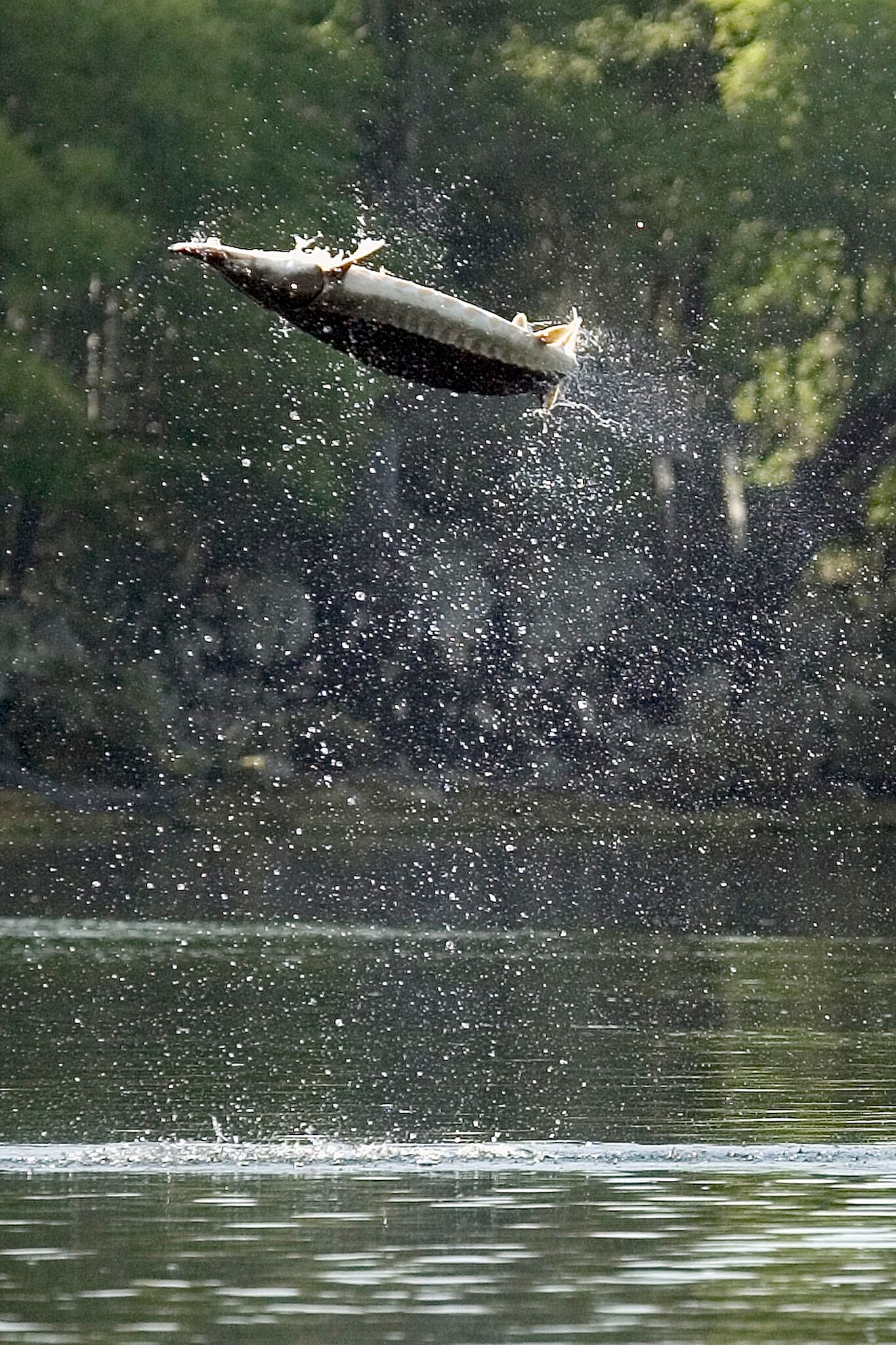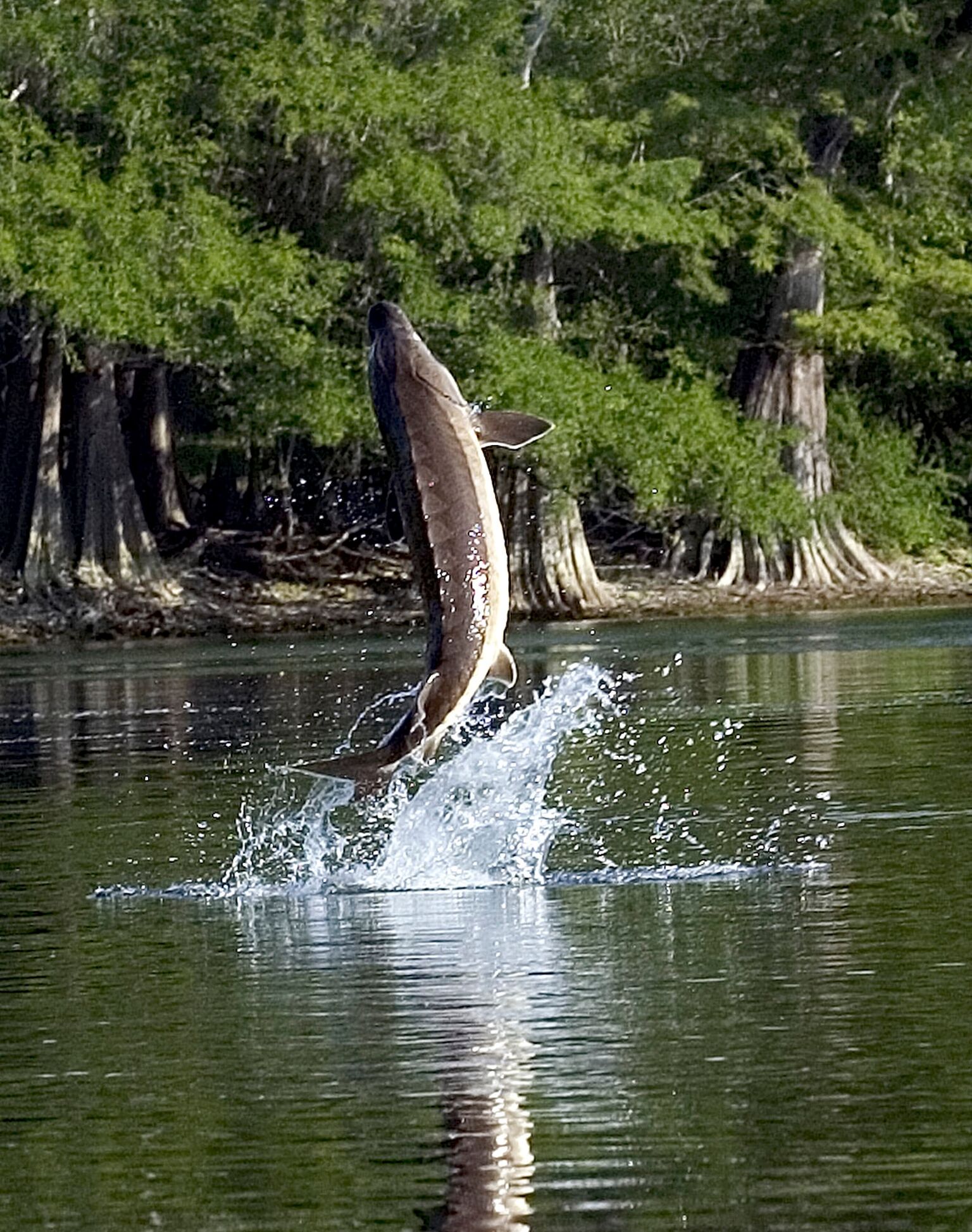Catching Air – Those Magnificent Jumping Suwannee Sturgeons
Ken Sulak, Fish Biologist
‘Sturgeon Quest’ leader, U.S. Geological Survey, Gainesville, FL
Final Revision – 14 September 2012
for submission to the “North Central Florida Coastal Angler”
APPROVED BY USGS
It starts deep at the bottom of the dark silent river – 3 to 4 powerful tail beats and three sharp acoustic clicks. Then a sudden upturn of the body and the fish explodes upward, 100 pounds going vertical, catching air, lots of air. A good jump can power a big fish 6-9 feet into the air. You have to be quick to get a photo; hang time is only about a second. But an accomplished jump by a big old Suwannee River Gulf sturgeon is impressive, a magnificent display of power. The exit is almost vertical, the tail continues to beat back and forth as the fish rises. Then comes a half-twist of the body, sometimes a full 180 degree twist, followed by that signature loud body smack on the surface, a sturgeon version of the belly-flop. Nothing else on the river sounds like it. If you happen to be close by, the report is really impressive – if not downright scary. In the calm of the night, when the air is still and narry a boat is stirring, that startling report can be heard from a mile or more away, even further underwater by another sturgeon. A loud splash upon re-entry isn’t the end of the sequence. At the peak of its jump, the big fish gulps air, re-filling its long swimbladder. Hitting the water, it immediately powers down deep, emitting one more sharp snapping sound on the way down, disappearing into the deep for another day.
No, it is not the same fish jumping repeatedly in the same spot, but hundreds of fish in the same area, each jumping about once a day, most commonly in the early morning. Jumping is rarely a solitary event. And, it is Gulf sturgeons of all sizes (1 to 8 feet long) that join in the show. In mid-summer, June and early July before the thunderstorm season really gets rolling, jumps can occur as frequently as 6-10 times per minute in the best areas. The inexperienced juveniles may not quite have it down exactly, sometimes coming out at odd angles, or forgetting to do the body twist. Then, some of the biggest fish occasionally seem to lack enthusiasm, only getting halfway out of the water, then flopping sideways.
Regardless of size or skill, jumping is an essential part of life for the Gulf sturgeon. But, jumping has nothing to do with shedding parasites, capturing prey, spawning courtship, reacting to boat noise, or attacking fishing boats. Sturgeons have been around and most likely jumping for over 100 million years, long before humans arrived on the scene, and long before mankind invented boats and motors. Before sturgeons were commercially fished, before dams blocked their migrations, and before pollution devastated fish population, sturgeons existed in truly astounding numbers. Even in colonial days, when sturgeons were the dominant large fishes inhabiting North American rivers, jumping was in full swing. The colonial naturalist, Mark Catesby[1], observing Atlantic sturgeon jumping in the Savannah River in the early 1700s summed it up very elegantly:
“…in May, June and July, the rivers abound with them [sturgeons], at which time it is surprising, though very common to see such large fish elated in the air, by their leaping some yards out of the water; this they do in an erect posture, and fall on their sides, which repeated percussions are loudly heard some miles distance in still evenings; it is also by this leaping action that many of them are taken, for as some particular parts of the rivers afford them most food, to those places they resort in greater plenty. Here the inhabitants (as the Indians taught them) place their canoes and boats, that when the sturgeon leap, these boats and canoes may receive them at their fall. It is dangerous passing over these leaping holes, as they are called, many a canoe, and small boat having been overset by the fall of a sturgeon into it.”
Using underwater acoustic investigations near Manatee Springs in 2011, the USGS Sturgeon Quest research team has learned that sturgeons ‘talk’ to each other. They communicate by producing loud sharp snaps, often emitted in an evenly-spaced series of three: snap-snap-snap. For about a mile of river, the deep channel below Manatee Springs serves as a sturgeon summer ‘holding’ area, one of about ten such holding areas in the entire river. Put a high-end hydrophone in the water when no boats are around and what you hear are lots of snapping sounds – punctuated by those loud jumping sounds. In 2011, our Sturgeon Quest team recorded these snapping sounds and discovered that each snap has the same characteristic wave form, frequency, and duration. By strange coincidence, a few days later, a diver called to report hearing repeated snaps or clicks while diving near Troy Springs. He initially suspected a gear malfunction, but nothing seemed amiss. Then he realized that the chorus of snapping sounds had to be coming from a group of nearby sturgeons. Nice visual confirmation that those snapping sounds are Gulf sturgeon vocalizations.
Yes, you might see a sturgeon jump just about anywhere up and down the river. But the real action is in these deeper holding areas. If you do not have a boat, the State Park pier at Manatee Springs is a great place to view jumping sturgeons. Another is from the old railroad trestle crossing the Suwannee just north of Old Town, now part of a hiking and biking path. Hundreds of these great river beasts congregate, hanging out deep, resting for the season after a winter of intense feeding out in the Gulf. They like it deep and dark, where they can rest without bucking the strong surface current, down where secretive sturgeons can hide in the tea-dark water. Sturgeons do not feed in summer, so they are rarely hooked by anglers. If they did not jump, you would never know that the Suwannee is home to about 15,000 impressively large fish. No, they are not seeking refuge from summertime warm water. That is an old myth, borrowed from up north where midsummer water temperatures are a real problem for cold-water fishes, adapted to northern waters. Down here in Florida, those sturgeons have been around for maybe 50,000-100,000 years, certainly since the end of the last ice age (15,000 years ago). Gulf sturgeons are nicely adapted to our warmer waters. These aren’t snowbirds suffering in the Florida heat. They can handle summer water temperatures up to 90 degrees, no problem. But the Suwannee normally hovers around 75-80 degrees in summer, rarely heating up like other Gulf sturgeon rivers. Sturgeons actually begin to settle into holding areas in early spring, when the river is still cold. Carrying a lot of fat from 5-6 months of winter feeding, they congregate in long deep runs below deeper holes, hovering down below the current where the swimming is easy. Each holding areas is a safe haven for hundreds of sturgeons, April through September, where they can hang out and slowly digest 20 percent of their body mass without feeding. Particularly during periods of low water, sturgeons concentrate in these deep holding areas. Jumping activity gets intense then –and so does the level of sturgeon communication by clicking sound production.
But loitering in the deep, conserving energy, hovering just about the bottom, requires neutral buoyancy. In the same way that a SCUBA diver stays neutral by inflating his buoyancy compensator (BC), a sturgeon must somehow do the same thing. Running almost the length of the body, the long swimbladder serves the same purpose. A long duct connects the swimbladder to the gut, enabling the fish to refill its version of a ‘BC’ by gulping air. But, although the duct can be constricted, air is gradually lost, absorbed into the body tissues. At some point, about once a day, the sturgeon ‘BC’ needs refilling. The fish gets antsy wasting energy trying to stay neutrally bouyant at depth. And that’s when it suddenly accelerates and rockets to the surface. OK, but why not just swim slowly to the surface, stick the head up, and take a mouthful of air? The problem then is getting back down to the bottom with a freshly re-inflated bladder. It is practically impossible to dive back to the bottom with a full BC, and nature did not provide these ancient fish with dive weights. The solution is to get as much elevation as possible, gulp air, then hit the water hard and power back down to the bottom. And that is exactly what sturgeons do.
But nature is rarely satisfied with solving one problem at a time. In most fish species, jumping is either a means of escaping larger predators, or a means of capturing smaller prey. In the Gulf sturgeon, jumping is a necessary part of life, to keep that swimbladder full and functional. Nature has found a second use for sturgeon jumping – group communication. Those ancient sturgeons behave more like herd mammals than like modern schooling fishes. Some Russian scientists say they are not really fish at all, but something else altogether. Sturgeon jumps, accompanied by a series of underwater snap sounds before and after, form a characteristic sequence, what scientists call ‘a fixed behavioral pattern’. It would be tough to prove scientifically, but is seems inevitable to conclude that those magnificent sturgeons with their impressive jumps are simply letting each other know where the group is hanging out. Just like herd of cattle loosely hanging out together in a field, mooing to let each other know the right place to be.
People either love or hate them, describing the ancient armored torpedo-shaped fish as either really nifty or truly ugly, either a delight to behold or a nuisance to power-boating on the Suwannee River[2]. Either way, it is difficult not to be impressed by the aerial acrobatics of an armored 6-foot long sturgeon, and by the loud report when that fish hits the water. And, it is equally difficult not to be impressed with how nature has solved two very different problems at once. An ancient escape pattern, jumping to avoid being eaten, has evolved into a way to control underwater buoyancy, and simultaneously a means of acoustic communication. Why do sturgeons jump you ask? Now you know!
[1] Catesby, M. 1731. The natural history of Carolina, Florida and the Bahama Islands. Vol. 1. London.
[2] Boaters – be safe, when the sturgeon are flying, don’t power full-tilt mid-river through a holding area. Instead, slow down and hug the shore. Those jumpers need depth to accelerate, so most jumps occur away from the shoreline.


